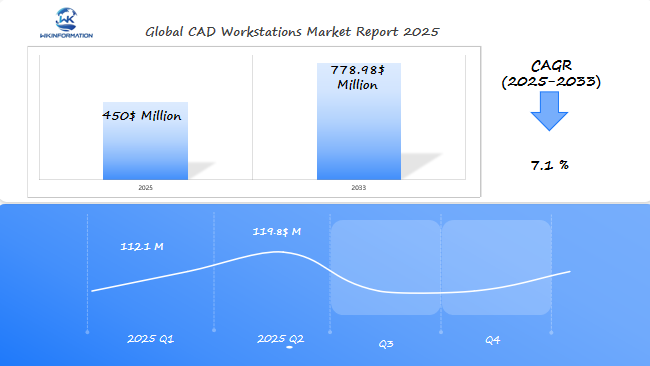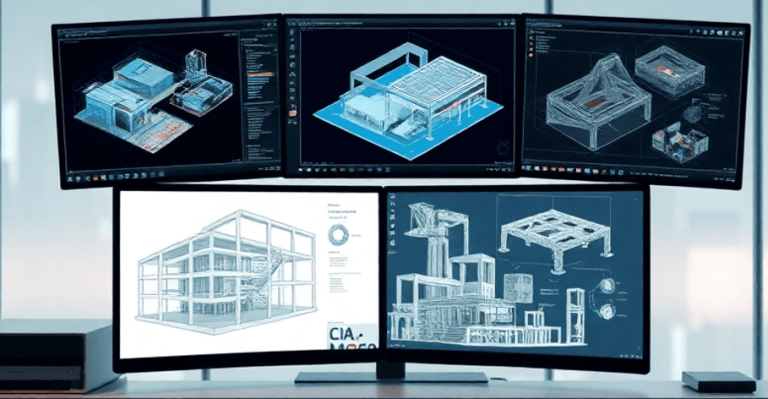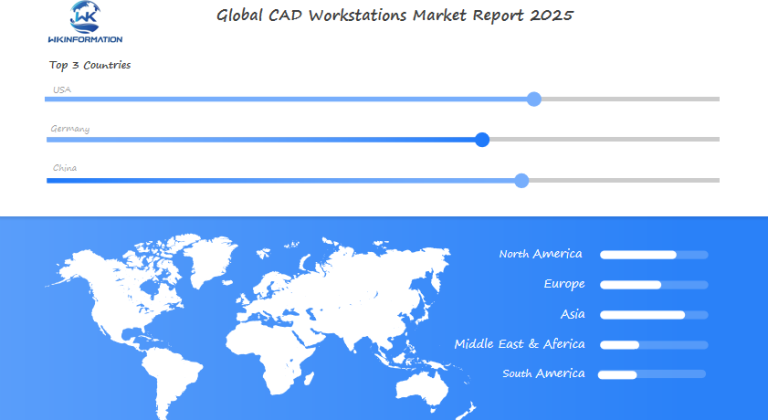2025 CAD Workstations Market Expansion Tapping into $450 Million Demand in US, Germany, and China
Explore the 2025 CAD workstations market, driven by high-performance design demands in the US, Germany, and China amid tech policy challenges.
- Last Updated:
CAD Workstations Market Projection for Q1 and Q2 2025
The CAD Workstations market is anticipated to reach around USD 450 million in 2025, with a CAGR of 7.1% from 2025 to 2033. In Q1 2025, the market is expected to reach approximately USD 112.1 million, with Q2 2025 growing to around USD 119.8 million. The US, Germany, and China are leading the market due to their strong technology sectors and growing demand for sophisticated design and engineering tools. The US remains the dominant market, followed by China, which is making significant strides in its manufacturing and design industries. Germany also continues to expand as a key hub for CAD technologies, particularly in automotive and industrial design.

CAD Workstations Market Supply Chain and Its Industry Impact
The CAD workstations market supply chain is composed of multiple stages, including raw material sourcing, component manufacturing, assembly, distribution, and end-user deployment. Key components such as high-performance GPUs, CPUs, and memory modules are sourced from major semiconductor manufacturers like Intel, AMD, and NVIDIA. The industry faces challenges related to semiconductor shortages, logistics disruptions, and increasing production costs. These supply chain fluctuations impact workstation availability and pricing, affecting industries that rely on CAD software, such as architecture, engineering, and automotive design. Companies are adopting strategies like supplier diversification and localized manufacturing to mitigate risks and ensure a stable supply chain.
Major Trends Redefining the CAD Workstations Market in 2025
Several emerging trends are set to redefine the CAD workstations market in 2025. The integration of AI and machine learning into CAD software is driving demand for more powerful hardware, enabling faster rendering and real-time design optimizations. The rise of cloud-based CAD solutions is shifting demand towards hybrid workstations that balance local and cloud processing. Additionally, increasing adoption of remote and collaborative work models is encouraging investments in mobile and high-performance laptop workstations. Sustainability initiatives are also influencing workstation design, with manufacturers focusing on energy-efficient components and recyclable materials to reduce environmental impact.
Regulatory and Industry Restrictions Affecting the CAD Workstations Market
Regulatory factors play a critical role in shaping the CAD workstations market. Compliance with data security and intellectual property protection laws affects how CAD software and workstations are deployed, particularly in industries like aerospace and defense. Export restrictions on high-performance computing components, especially between the U.S. and China, have also impacted supply chains and pricing. Environmental regulations, such as e-waste disposal laws and energy efficiency standards, are pushing manufacturers to adopt more sustainable production practices. Navigating these restrictions requires industry players to stay compliant with evolving global and regional regulations while maintaining innovation and competitiveness.

How Geopolitics Is Shaping the CAD Workstations Market Outlook
Geopolitical tensions are significantly influencing the CAD workstations market by affecting trade policies, supply chain stability, and global demand. The ongoing U.S.-China trade disputes have led to increased tariffs and export controls on critical semiconductor components, disrupting the production and distribution of high-performance workstations. The Russia-Ukraine conflict has also contributed to supply chain uncertainties, particularly in raw material sourcing for semiconductor manufacturing. Furthermore, regional investment policies and government incentives, such as the CHIPS Act in the U.S. and Europe’s push for semiconductor independence, are reshaping the global landscape for CAD workstation production. Companies must adapt to these geopolitical shifts by diversifying suppliers, securing alternative component sources, and ensuring compliance with international trade regulations.
Applications Driving the CAD Workstations Market What to Expect in 2025
The CAD Workstations Market is driven by various industries, each with its own specific needs for accuracy and productivity. The main sectors fueling demand are:
1. Automotive
The automotive industry focuses on design innovation and relies on CAD workstations to create complex models and simulations that improve vehicle safety and performance.
2. Aerospace
This sector depends on CAD systems to produce highly detailed and precise models essential for studying aerodynamics and ensuring structural integrity.
3. Construction
With the rapid growth of cities, there is a rising demand for accurate architectural designs and building simulations, making CAD workstations crucial in this field.
4. Electronics
The intricate nature of electronic components requires advanced modeling capabilities to guarantee proper functionality and seamless integration.
Regional Developments and Investment Areas in the Global CAD Workstations Market
The CAD workstations market is spread across the globe, with North America being a significant region. This is mainly due to its strong manufacturing industry and the fast-paced technological advancements happening there. The region’s dedication to research and development (R&D) has solidified its position as a leader in using CAD workstations.
Key Investment Areas with Growth Potential
Several important areas show promise for substantial growth when it comes to investment opportunities:
- R&D initiatives aimed at developing next-generation workstation technologies are gaining traction.
- Companies investing in these areas stand to benefit from the evolving landscape of digital design solutions.
Regional Insights on CAD Technology Adoption
Here are some insights into how different regions are adopting CAD technology:
- North America: Significant investments in R&D are driving innovation in CAD technology.
- Asia-Pacific: Rapid growth fueled by digital manufacturing initiatives like China’s “Made in China 2025.”
- Europe: Sustainable design practices are influencing the adoption of CAD technology.
Investments in cutting-edge technologies not only enhance current offerings but also prepare stakeholders for future market demands. By prioritizing innovation, companies can harness emerging trends, maintain competitiveness, and meet industry-specific requirements effectively.
Understanding regional developments and investment areas is crucial for businesses looking to thrive in the ever-changing CAD workstations market.

Growth and Demand Forecast for CAD Workstations in the USA
A detailed analysis of the USA market shows a strong demand for CAD workstations, with major contributions from top companies like Siemens AG and Autodesk Inc. These industry leaders are driving technological advancements and innovation in various sectors.
Current State
The USA CAD workstations market is seeing widespread use of advanced design software. This trend is particularly noticeable in industries such as automotive, aerospace, and construction, where precision and efficiency are crucial. Companies like Siemens AG and Autodesk Inc. play a vital role in offering state-of-the-art solutions to meet these requirements.
Future Growth Trajectory
Forecasts suggest significant growth leading up to 2025, fueled by several factors:
- Increasing adoption of sophisticated design software among US enterprises
- Demand for enhanced collaboration tools that facilitate remote work environments
- Ongoing investments in research and development to refine CAD technologies
This growth trajectory highlights the need for continuous innovation and adaptation to meet changing industry demands. The ability of CAD workstations to seamlessly integrate with existing workflows further strengthens their position as an essential part of modern design processes.
The positive trend in the USA market sets the stage for exploring key trends and competitive dynamics shaping Germany’s CAD workstation market.
Key Trends and Competitive Environment in the Germany CAD Workstations Market
In Germany, the CAD Workstations Market is characterized by a strong inclination towards high-performance systems. Local firms prioritize cutting-edge technology adoption to enhance their design capabilities, meeting stringent industry standards in sectors like automotive and aerospace. This preference supports enhanced precision and efficiency in complex project executions.
The competitive environment in Germany is vibrant, with both local and international players vying for market share. Dassault Systèmes, a prominent local entity, leverages its deep understanding of European manufacturing needs to offer tailored solutions that resonate well with German enterprises. Their focus on innovation and customer-centric design solutions sets them apart.
Internationally, PTC Inc. plays a significant role by integrating advanced technologies such as AI and IoT into their CAD solutions, catering to the evolving needs of German industries. This competitive landscape fosters an ecosystem where continuous technological advancements are encouraged, facilitating the sustained growth of the CAD workstations market in Germany.
These dynamics underline the importance of high-performance systems in maintaining competitiveness within Germany’s industrial sectors, driving both domestic and international companies to innovate continuously while addressing localized requirements effectively.
Strategies for Expansion in China's CAD Workstations Market
In recent years, China’s push towards digital manufacturing has significantly impacted the CAD workstations market. The Made in China 2025 initiative exemplifies this focus, aiming to advance the country’s manufacturing capabilities through technology integration. This policy has fueled the demand for sophisticated design tools such as CAD workstations, essential for achieving precision and efficiency in manufacturing processes.
Several companies have adopted strategic approaches to capitalize on this growing market. Key strategies include:
- Forming Partnerships with Local Distributors: Collaborating with local entities allows foreign firms to navigate China’s complex regulatory landscape more effectively. These partnerships also help companies tap into existing distribution networks to reach a broader customer base.
- Investing in Local R&D: Establishing research and development centers within China not only supports technological innovation but also aligns products closely with local industry needs and standards.
- Leveraging Government Incentives: Taking advantage of subsidies or tax breaks offered under government programs can reduce operational costs and enhance competitiveness.
As these strategies unfold, they pave the way for successful expansion in China’s burgeoning CAD workstations market, aligning with both national goals and global trends in digital transformation.
Future Innovations and Developments in the CAD Workstations Market
Innovations in technology are set to redefine CAD workstations, enhancing both design capabilities and user experience. Emerging technologies such as high-performance computing (HPC) are expected to play a pivotal role in future workstation designs. HPC capabilities will allow for faster processing speeds and more complex computational tasks, enabling designers to tackle increasingly intricate projects with ease.
Virtual reality (VR) integration is another groundbreaking development on the horizon. By incorporating VR into CAD workstations, users can achieve enhanced visualization capabilities. This immersive approach allows designers to interact with their creations in a three-dimensional space, providing a more intuitive understanding of spatial relationships and design intricacies.
Key advancements also include:
- Augmented Reality (AR): Offering real-time overlays of digital information onto the physical world, AR can significantly improve design accuracy and collaboration.
- Artificial Intelligence (AI): With AI, CAD software can automate routine tasks, optimize design processes, and provide predictive insights for improved decision-making.
- Cloud-based Solutions: Facilitating better collaboration among teams by enabling access to designs from anywhere at any time.
These innovations promise to revolutionize the CAD workstations market, driving efficiency and creativity across various industries. The integration of these cutting-edge technologies will support more seamless and sophisticated design processes.
Who Leads the CAD Workstations Market: Competitive Strategies and Market Share
-
Digital Storm – United States
-
Dell Technologies – United States
-
Hewlett Packard (HP Inc.) – United States
-
Lenovo Group Ltd. – China
-
Asus (ASUSTeK Computer Inc.) – Taiwan
-
Broadberry Data Systems – United Kingdom
-
MSI (Micro-Star International Co., Ltd.) – Taiwan
-
Titan Computers – United States
-
Orbital Computers – United States
-
Maingear – United States
Overall
| Report Metric | Details |
| Report Name | Global CAD Workstations Market Report |
| Base Year | 2024 |
| Segment by Type |
·Fixed Workstation |
| Segment by Application |
·Architecture, Engineering & Construction |
| Geographies Covered | · North America (United States, Canada)
· Europe (Germany, France, UK, Italy, Russia) · Asia-Pacific (China, Japan, South Korea, Taiwan) · Southeast Asia (India) · Latin America (Mexico, Brazil) |
| Forecast units | USD million in value |
| Report coverage | Revenue and volume forecast, company share, competitive landscape, growth factors and trends |
Industries across the US, Germany, and China are positioned to leverage high-performance CAD workstations for competitive advantage in a digital-first world. The increasing demand for these advanced systems underlines their pivotal role in sectors like architecture, manufacturing, and media. While technological advancements propel this growth, industries must navigate potential trade policy hurdles, particularly those stemming from Trump’s tech manufacturing policies.
To maintain competitiveness:
- Focus on integrating high-performance CAD solutions into existing workflows.
- Stay informed about policy changes that could impact international trade and manufacturing.
For an enriched understanding and strategic insights, consider exploring the detailed findings in the complete Wkinformation Research report. This comprehensive resource delves deeper into the 2025 CAD Workstations Market: US, Germany, and China Driving Demand for High-Performance Design and Engineering Amid Trump’s Tech Manufacturing Policies.
Global CAD Workstations Market Report (Can Read by Free sample) – Table of Contents
Chapter 1: CAD Workstations Market Analysis Overview
- Competitive Forces Analysis (Porter’s Five Forces)
- Strategic Growth Assessment (Ansoff Matrix)
- Industry Value Chain Insights
- Regional Trends and Key Market Drivers
- CAD WorkstationsMarket Segmentation Overview
Chapter 2: Competitive Landscape
- Global CAD Workstationsplayers and Regional Insights
- Key Players and Market Share Analysis
- Sales Trends of Leading Companies
- Year-on-Year Performance Insights
- Competitive Strategies and Market Positioning
- Key Differentiators and Strategic Moves
Chapter 3: CAD Workstations Market Segmentation Analysis
- Key Data and Visual Insights
- Trends, Growth Rates, and Drivers
- Segment Dynamics and Insights
- Detailed Market Analysis by Segment
Chapter 4: Regional Market Performance
- Consumer Trends by Region
- Historical Data and Growth Forecasts
- Regional Growth Factors
- Economic, Demographic, and Technological Impacts
- Challenges and Opportunities in Key Regions
- Regional Trends and Market Shifts
- Key Cities and High-Demand Areas
Chapter 5: CAD Workstations Emerging and Untapped Markets
- Growth Potential in Secondary Regions
- Trends, Challenges, and Opportunities
Chapter 6: Product and Application Segmentation
- Product Types and Innovation Trends
- Application-Based Market Insights
Chapter 7: CAD Workstations Consumer Insights
- Demographics and Buying Behaviors
- Target Audience Profiles
Chapter 8: Key Findings and Recommendations
- Summary ofCAD Workstations Market Insights
- Actionable Recommendations for Stakeholders

Access the study in MULTIPLEFORMATS
Didn’t find what you’re looking for?
TALK TO OUR ANALYST TEAM
Need something within your budget?
NO WORRIES! WE GOT YOU COVERED!
Call us on: +1-866-739-3133
Email: infor@wkinformation.com
What is the projected growth of the CAD Workstations Market by 2025?
The CAD Workstations Market is expected to experience substantial growth by 2025, driven primarily by increasing demand for advanced design solutions across various industries.
How do supply chain disruptions impact the CAD Workstations Market?
Supply chain disruptions can significantly affect market growth and stability in the CAD Workstations Market, as they can hinder the availability of essential components and delay production schedules.
What regulatory challenges do companies face in the CAD Workstations Market?
Companies in the CAD Workstations Market must adhere to key regulations and industry standards, facing compliance challenges that can impact their operational efficiency and market access.
How does geopolitics influence the CAD Workstations Market outlook?
Geopolitical tensions can shape market dynamics by affecting trade policies, which in turn influence imports and exports of CAD workstations between countries, creating both challenges and opportunities.
Which industries are driving demand for CAD workstations?
Industries such as automotive and aerospace are major drivers of demand for CAD workstations, each having specific requirements that emphasize precise modeling for their operations.

